 This is a special article dedicated to flight attendants and the history of their uniforms. It’s our way to support and cheer up the cabin crew members during the pandemic of Covid-19, which would probably cause a lot of flight attendants to lose their jobs. And the only thing we can do about it is social support. The air travel knew a lot of bumps and difficulties throughout its history, which influenced the cabin crew uniforms and fashion trends of the time. But always, time moved forward and everything changed for the better. Let’s hope the same will happen this time, too.
This is a special article dedicated to flight attendants and the history of their uniforms. It’s our way to support and cheer up the cabin crew members during the pandemic of Covid-19, which would probably cause a lot of flight attendants to lose their jobs. And the only thing we can do about it is social support. The air travel knew a lot of bumps and difficulties throughout its history, which influenced the cabin crew uniforms and fashion trends of the time. But always, time moved forward and everything changed for the better. Let’s hope the same will happen this time, too.
The article is based on a video by Amanda Hallay, fashion historian
The 1910s
From the very start of commercial air travel in the 1910s, what flight attendants wore spoke to more than just fashion trends, it spoke to the very zeitgeist of each era. It's a fascinating story and it starts not with a female flight attendant but with a man.
This man. He was called Heinrich Kubis and he wasn't a steward on a plane, he was a steward on a zeppelin.
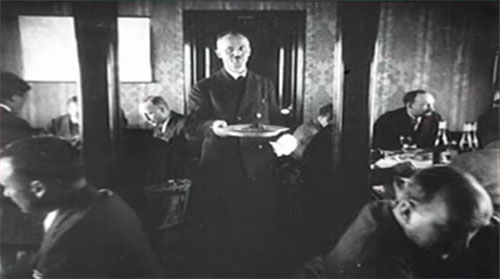
He's dressed in the same way that every maitre d’ was dressed in the 1910s. Just like waiters and chefs were dressed the same as the stuff on the ground. At the start of commercial flight, there was no difference between what waitstaff in the air and weight stuff on the ground wore.
And also, in the first couple of decades of commercial flight, people weren't exactly sure what the job of a flight attendant actually was. It was a new concept after all.
The 1920s
With the start of passenger plane flights in the 1920s, only male flight attendants were hired and either called “stewards” or “cabin boys”. And you can see from this image that their uniform has moved away from the head waiter maitre d’ look we saw in the 1910s into this quasi-nautical look we see here.
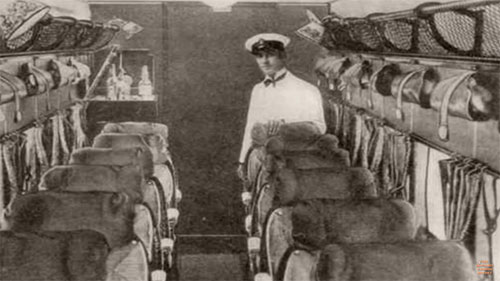
The 1930s
Things were changed dramatically in 1932 when the world met its first female flight attendant. She is called Ellen Church. Ellen was a nurse and was employed because she was a nurse, the idea being that nurses would not only be useful if a plane should crash but because they would have a calming and reassuring effect on passengers.
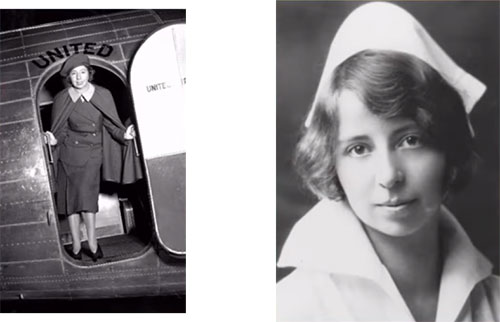
This was truly a new career for women. So, what should she wear? Remember that female flight attendants of this era also had to help with refueling planes, handling the luggage, serving drinks, serving food, etc. This confusion as to what the role of a flight attendant actually was is reflected in the first cabin crew uniforms.
You'll see that the uniform involved a cape, and capes were traditionally worn by nurses. But the idea of a woman in the man's world of aviation also threw up sartorial questions, and the rather drab color and pseudo-military look of the suit seems inspired by the uniforms of World War I. These two concepts combined into this – the first dedicated female flight attendant uniform. It’s part hospital, part army; it seems intentionally unglamorous, yet somehow reassuring and conveying an air of confidence and authority.
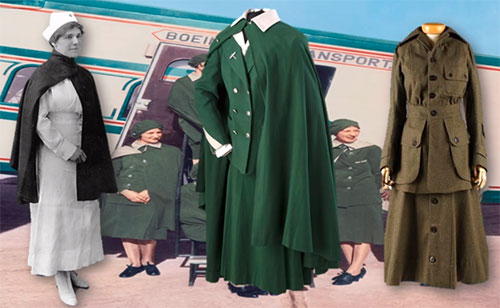
The second generation of uniforms were slightly more stylish and have lost the cape.
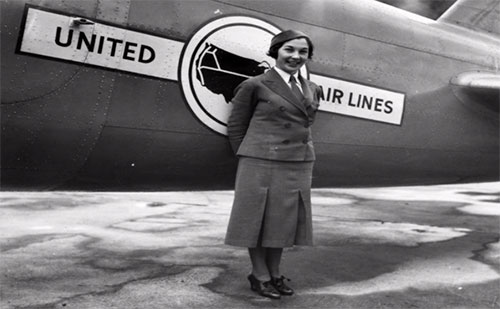
Although, some airlines doubled down on the idea of nurses being a selling point in flights. Here’s a photo – the ensemble worn by the flight attendant consists of a white button-down dress, white socks, white cap. It evokes the nursing profession, but that little military-style jacket speaks to naval uniforms. It was all a bit of a mix-up.
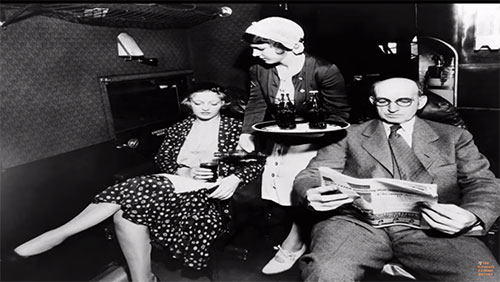
For male cabin crew of the 1930s, it was easier. Drawing directly from nautical uniforms but with a bit of glamour.
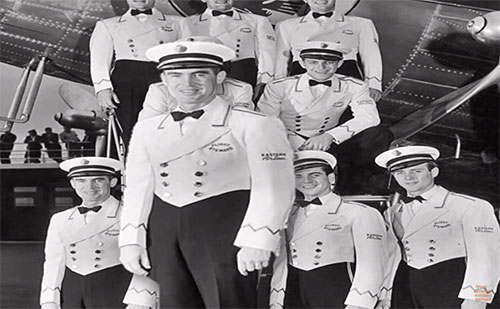
Male flight attendants needed no medical training, and that requirement would disappear for women by the middle of the decade, as did her role in refueling and plane maintenance, which led to further confusion as to what she should wear.
Here is an idea favored by many airlines – let her wear her own clothes.
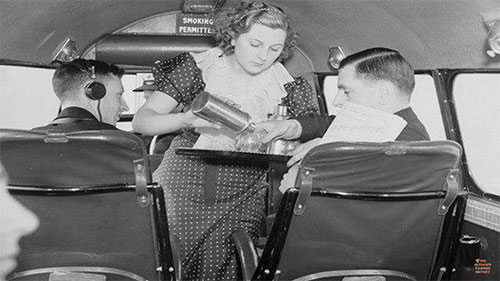
As planes became more comfortable, with more of a focus on cabin design, so did the uniforms of flight attendants. Some uniforms even incorporated pants. Women wearing trousers in a work setting was more or less unthinkable in the demure 1930s, so this would have been seen as very trendy, cool, and daring.
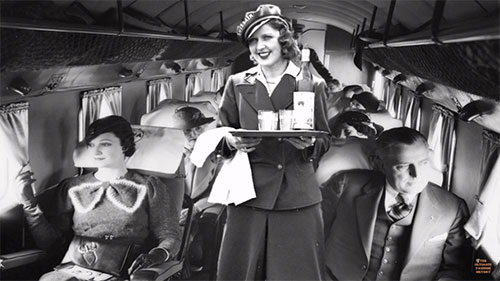
Passenger aircraft really evolved throughout the 1930s. From very cramped little planes with wicker seats to a stylish interior. And uniforms began to echo the aesthetic appeal of flight – the more chic the uniform, the better the airline.
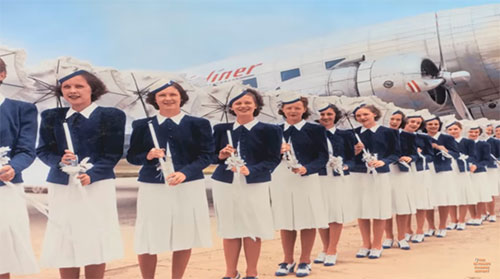
Just look at these TWA uniforms from 1939, with their fashionably padded shoulders, scalloped jacket hem, and knee-length skirts. This was very fashionable, very cool, and, of course, mirrored the luxurious elegance of the plane cabin.
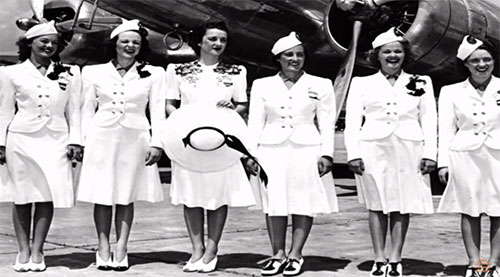
The 1940s
In the 1940s, cabin crew attire reflected what absolutely everything else in the world reflected – World War II. Just as civilian fashion, with its ration-driven utility suits closely mirrored the uniforms of women in service, so would flight attendant uniforms, usually worked in the blues and browns of waves and wax and featuring embellishments that suggested a military uniform (brass buttons, gold piping, that kind of thing).
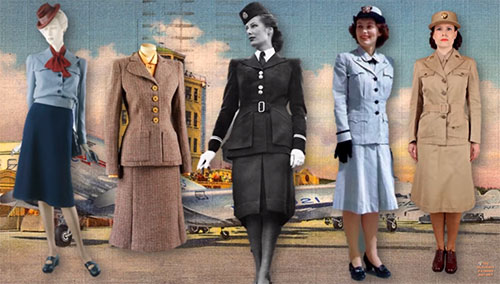
During the war, there was very little to distinguish flight attendant uniforms from their military counterparts.
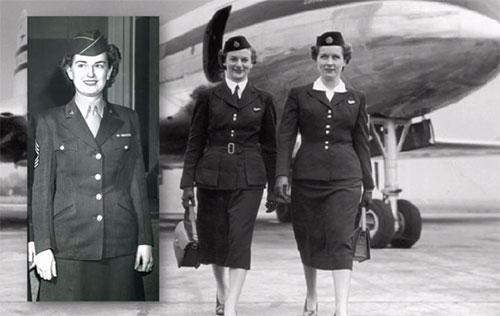
But there were a few really notable exceptions. For example, Hollywood designer Howard Greer's 1944 uniform for TWA. It was called the “cutout” and it featured something called a “blouse slip” – a sort of elasticated blouse.
It was actually attached to the skirt so that cabin crew won’t forever tucking their blouses into their skirts after reaching into overhead bins. This attire was called the “cutout” because of a very clever feature that speaks to the image of a flight attendant or stewardess or hostess, as they were called back then, being a perfect representation of her airline.
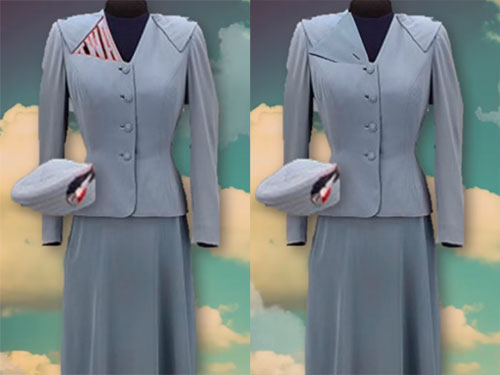
There is a beautifully stylized TWA logo just below the shoulder. On the shoulder, there's a button-down flap, which the flight attendant could unbutton and re-button to conceal the logo. Why would she want to do this? Because cabin crew were not allowed to drink or smoke in uniform, so on a layover, if she wanted to go on a boozing chain-smoking bender, she could cover the logo and be left with a chic Howard Greer suit.
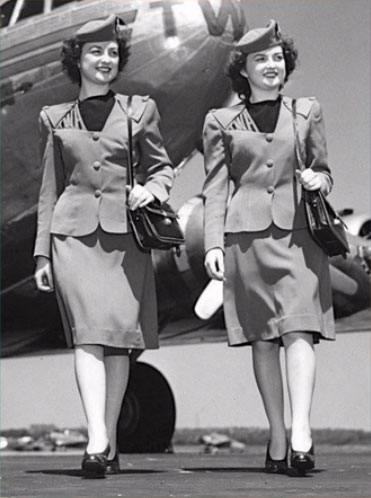
The 1950s
The 1950s through to the early 1960s – we were truly living in the Golden Age of air travel. Although still horribly expensive, air travel was being enjoyed by more and more people. The job of a flight attendant was seen as glamorous, adventurous, and fun. It was a role that many little girls dreamed of attaining. And the role of the flight attendant in the 1950s was reflected in her wardrobe. It was all about service and efficiency, a somewhat motherly role as ultimate carer, and the standards that airlines exacted would be unthinkable today.
With age, weight, and height restrictions, female flight attendants had to be unmarried and, once employed by an airline, they were required to hold a standard of poise, elegance, neatness, and perfection.
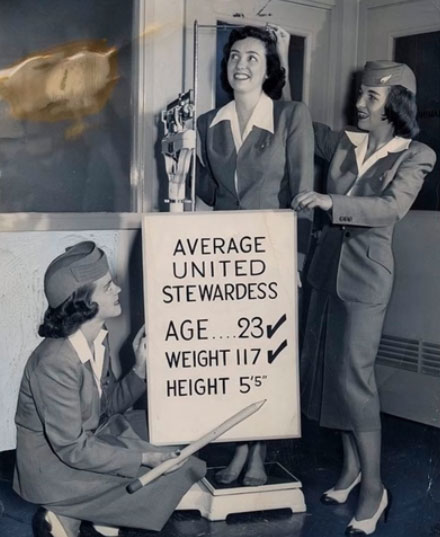
There were certain grooming tips. They go on and on, everything from clean hair to how to do your manicure to reminding you to change your underwear every day, keeping your armpits hairfree. Of course, this is extremely sexist but it wasn't sexualized – that will come later.
The cabin crew uniforms at the time were sleek and slim-fitting suits and blues and grays for the order of the day, hats and gloves, and imagine the undergarments (those girdles and suspenders). On a long-haul flight, this must have been extraordinarily uncomfortable. But everyone was actually extraordinarily uncomfortable in 1950s fashion.

This New Look silhouette and highly tailored treatment was mirrored in cabin crew uniforms. Like this one by Oleg Cassini for TWA.
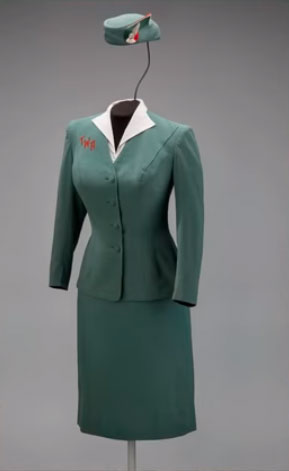
And here's a mid-century uniform by Hollywood designer Don Loper.
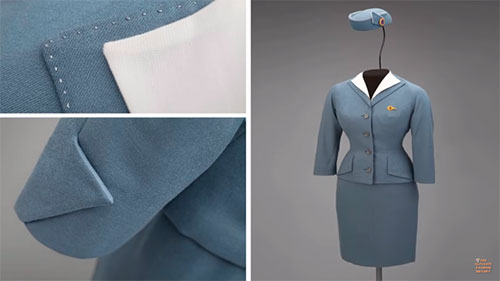
Throughout the world, flight attendant uniforms adopted this sartorial rigidity – the tight-fitting undergarments, the neat little suits, the stiletto heels, the gloves. It really was an international standard.
Although occasionally, the suit could be swapped for a dress, dresses were worn, it seems, only for shorter domestic flights during daylight hours.
The 1960s
As we move into the early 1960s, the immaculate suit remained but the silhouette changed into the more boxy cut of the Kennedy era, equally stylish but a little more comfortable.
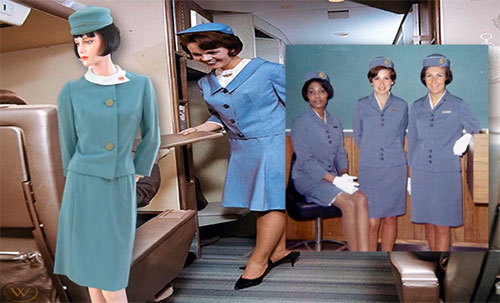
Male flight attendants in this era were few in number. During the war, the profession was dominated by women. In the 1950s and early 1960s, many flights employed men but they were sort of head flight attendants. Men wore either swanky waitstaff outfits or formal uniforms.
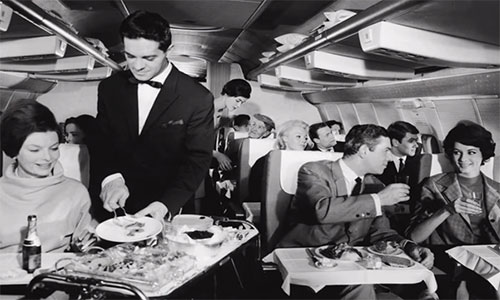
The role and the wardrobe of the flight attendant would change drastically by the time we hit the middle of the 1960s. This change exemplified perfectly by this TWA ad.
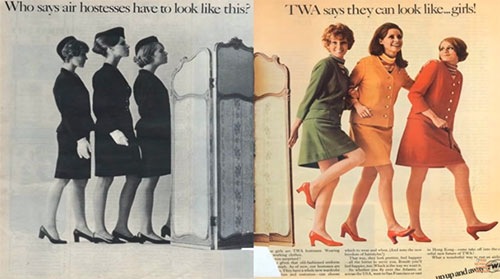
In the 1960s, came new airlines and huge competition that had cabin crew as the focus. Who could be the modest, the hippest, the youngest, the grooviest?
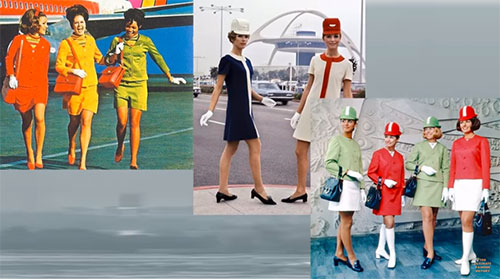
The youthquake has happened, and airlines seized upon it. Gone was the idea of prim and poised in-flight mothers, in its place – cool and kicky girls who embraced the spirit of the times. For the most part, gone were the suits, in their place – the British invasion mini-dress. The shorter the skirt, the hipper the airline.
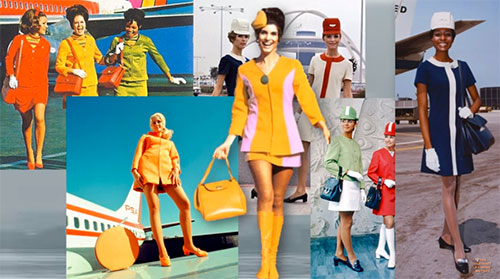
But what if an airline generated in a culture that didn't wear miniskirts? Such airlines as Pakistan International Airways and others used stylish but modest uniforms. Here’s one of the ideas: the hijab could be pulled down to create a cowl-neck if wished. Not only was the silhouette and the spirit completely different in these uniforms, so was the palette.
The 1960s were a unique era for the plain interior and cabin crew uniforms. Sometimes, both looked rather bizarre. Look at these seats from the 1960s.
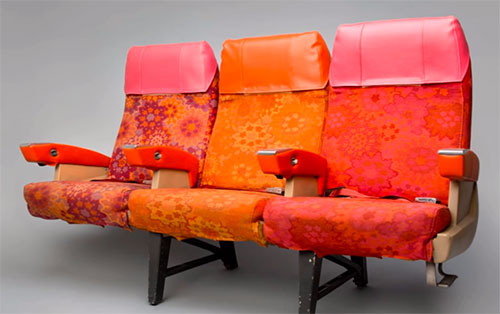
And these are flight attendant uniforms designed by Emilio Pucci for the Braniff Airways. Look at his candy-colored collections for the airline. He designed for Braniff for about 10 years and his vision went from these cool confections to psychedelic wonders. Perhaps, his most famous piece of kit was the sky bubble helmet to protect a flight attendant’s quaff on the runway.
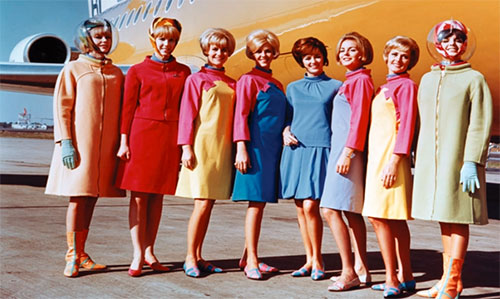
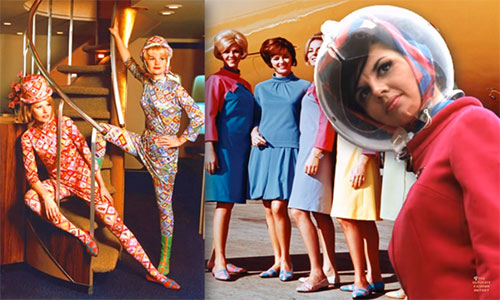
Unfortunately, in the 1960s, also began the sexualization of flight attendants. Over 80% of the airline tickets were still being purchased by men, and so the idea of the promise of sex or even a fantasy of sex really was used to sell. And this was obviously going to be reflected in uniforms. PSA famously had the shortest miniskirts of all.
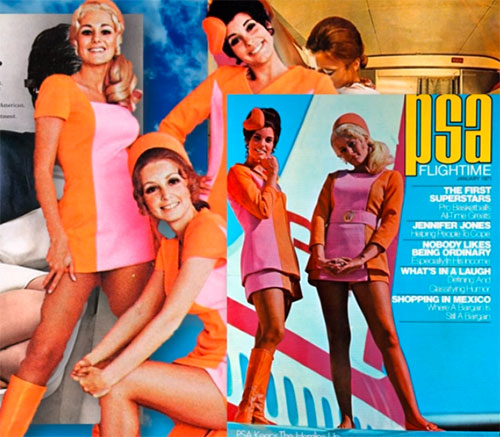
The 1970s
By 1971, this idea reached its epitome in what is arguably the most famous ad campaign in aviation history – National Airlines “Fly Me” campaign. It tapped into the sexual revolution, which was a trendy thing at the time. It's no wonder that airline uniform designers were so keen to jump on one of the early 1970s most ephemeral fashion trends – hot pants.

The top half of the uniform was standard conservative airline attire, and the bottom half – hot pants. Some of these hot pant outfits were actually quite terrific but it doesn't lend much to the gravities of the job.
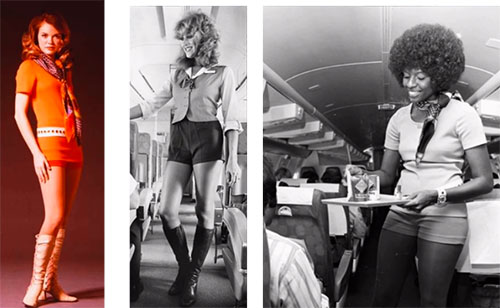
The hot pant trend lasted all of 2 years. However, airline uniforms are supposed to last at least 5 years. By the mid-1970s, all of this started to look rather dated. Some airlines, however, went in the opposite direction in this era, and, instead of selling the idea of sexy fun with their uniforms, they sold the idea of class and longevity.
Here’s another trend in action – folk clothing inspired uniforms. These beautiful kebayas that the cabin crew of Singapore Airlines wear. They were designed in 1968 by Pierre Balmain and they've never changed. Why? Because they don't have to.
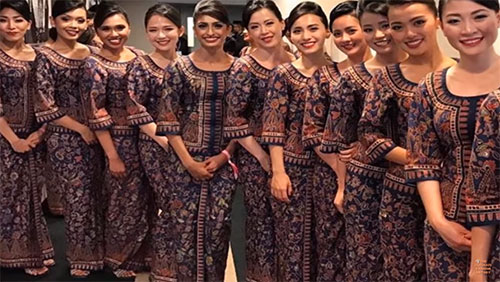
This era also saw the rise in national or regional motifs worked into cabin crew uniforms. Often, with no regard for cultural appropriation or taste. But there were good examples as well.
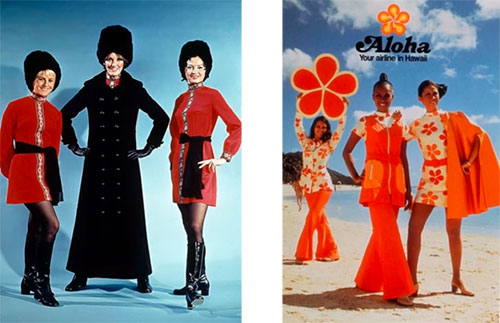
On some evening and night flights, cabin crew even wore evening wear.
By the middle of the 70s, there was a real move away from clothes that look like uniforms or clothes that look like costumes and towards uniforms that looked like stylish civilian clothing.
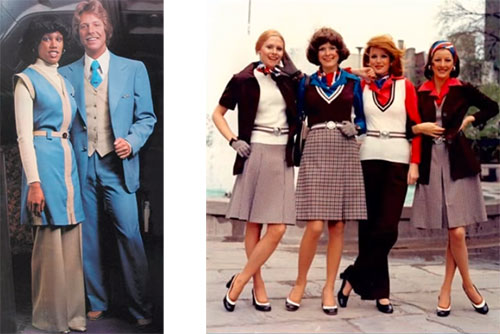
And because of the women's liberation movement, we see a dedicated embrace of pants.
This idea of uniforms not looking like uniforms was a unisex affair. Male cabin crew had been welcomed back onto flights.
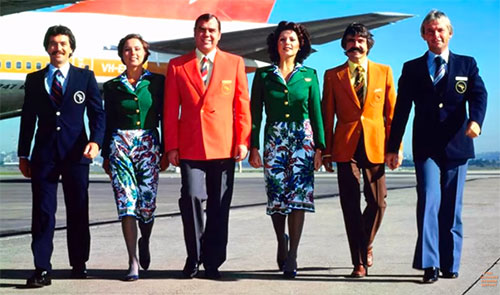
Here is the uniform of Braniff Airways, who employed Halston to design its uniforms. The cabin crew wore his beautiful collection of slinky silks and sophisticated suedes and chic browns and beiges.
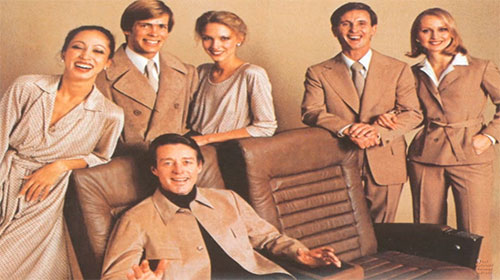
In fact, brawn would become pretty de rigueur in the second half of the 1970s in terms of cabin crew uniforms. And we see a return to the classic suit, instantly recognizable as a uniform. The women's liberation movement’s influence on flight attendant female fashion saw a real return to more businesslike attire. Take away the airline emblems and this suit could have been worn to work.
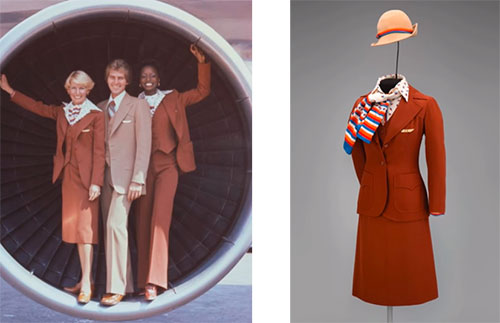
The 1980s
With the 1980s, came the trend for massive padded shoulders and pastels and calf-length floral skirts and huge oversized jackets. It was all absolutely fashionable at the time, but remember, these uniforms had to last 5 or 6 years.
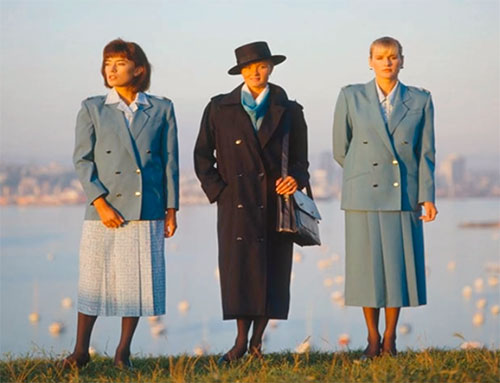
Fortunately, in the 1980s, some designers were natural forecasters and created uniforms that would work well into the 1990s.
Like these uniforms.
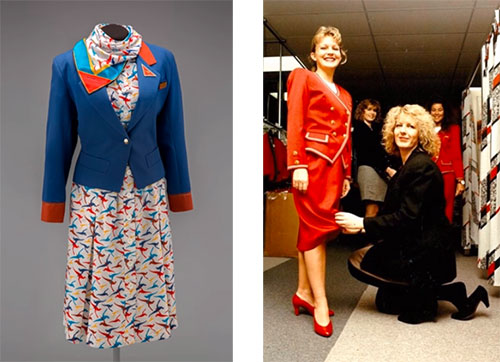
The 1990s
In terms of eye-catching style, the 1990s weren’t perhaps the most exciting of the decades that we've looked at so far, airlines were competing over prices, not the in-flight experience itself. An interest in styles seems to have gone out the window replaced with the promise of budget flights. Things were pretty bland uniform-wise – utility and a general lack of aesthetic interest seemed to rule. Even beautifully-cut and stylish suits were designed for sensible longevity.
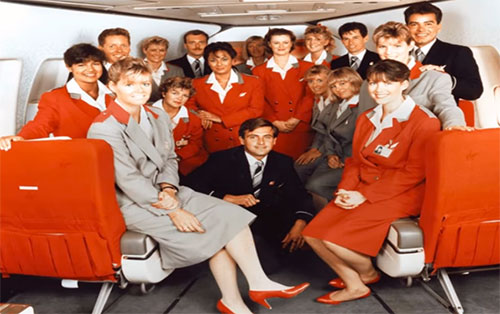
The 2000s
After the awful events of 9/11 and the airline crisis that followed, the 2000s gave airlines a chance to rather reinvent themselves. The ubiquitous flight attendant suits were replaced with a stylish and form-fitting dress.
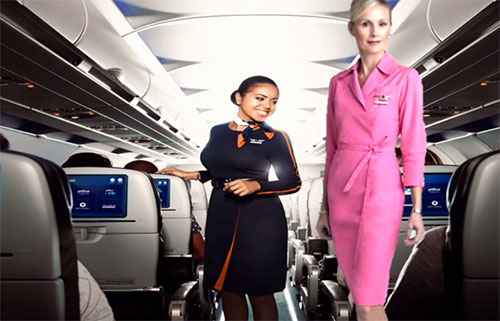
The 2010s
In an attempt to combat the increasingly cattle-ranch vibe of the 2010s, many airlines have attempted to return passengers back to that Golden Age of air travel. And in response, cabin crew uniforms have taken on a fabulously slick and stylish retro vibe.
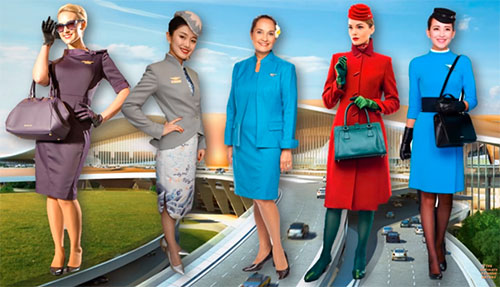
The 2020s
As we started the 2020s with a worldwide pandemic, airlines have responded with a new type of cabin crew uniform – the stylized hazmat suit, like this one from Air Asia or this one from Philippine Airlines.
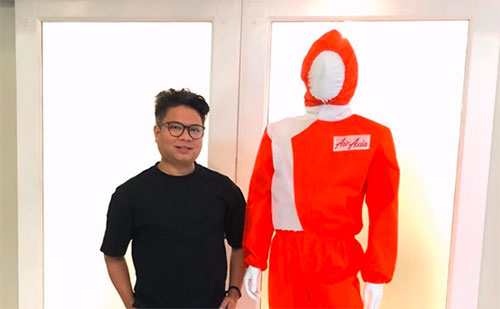
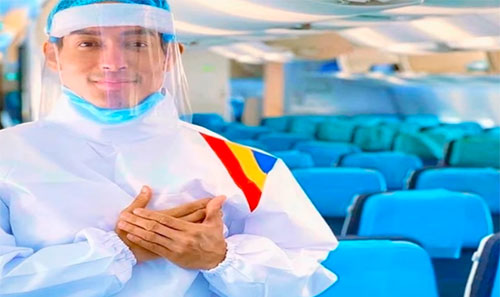
Will air travel ever be the same again?


